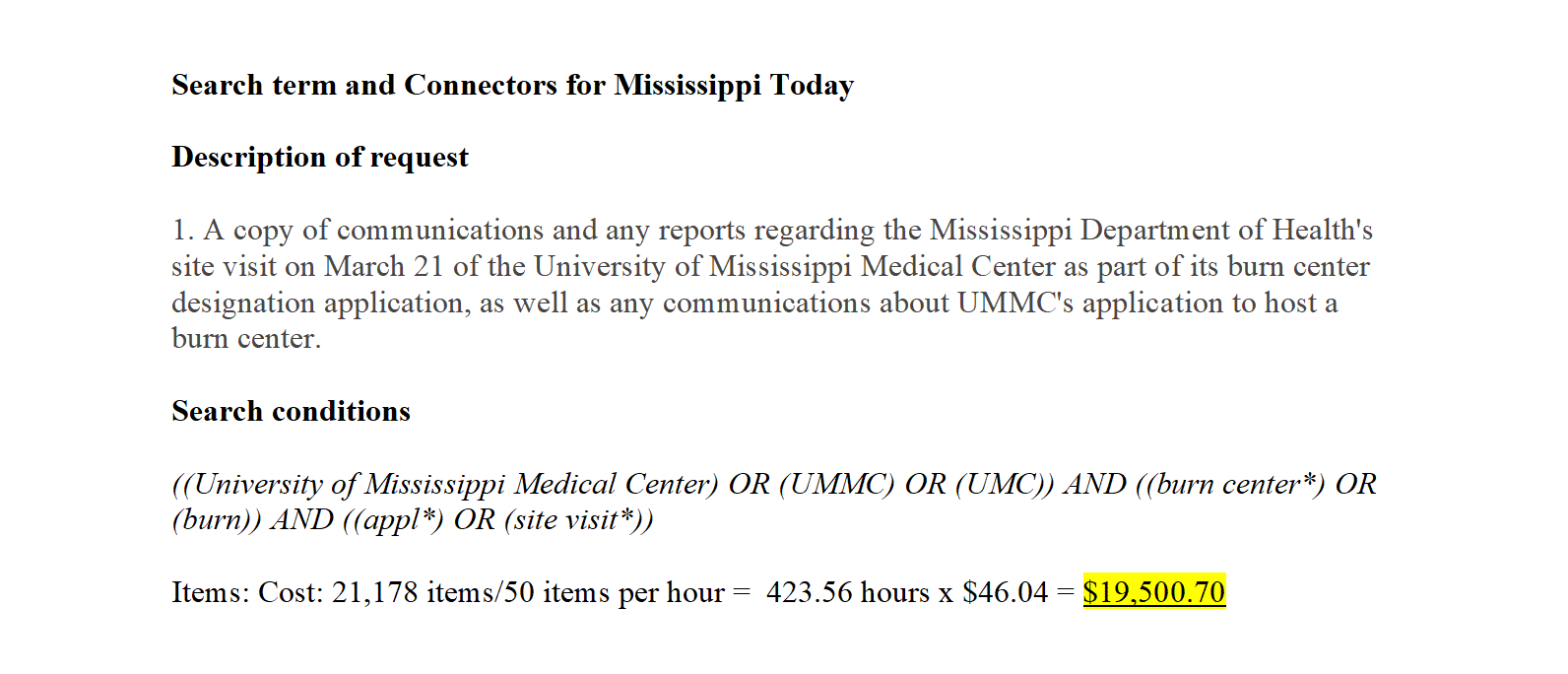Mississippi Today
UMMC didn’t fully meet criteria for burn center, March report shows
The March inspection of the University of Mississippi Medical Center for its burn center designation showed the health system failed to fully meet almost a third of criteria required to host the state’s next burn center, though it was recently deemed qualified to do so anyway.
UMMC communications officials refused to answer Mississippi Today’s questions about the current status of its burn program, including its staff’s training. A Facebook post, however, shows that since the health system’s application to host a burn center was submitted and the subsequent site visit was conducted, more staff have undergone the training required to care for burn patients.
The Mississippi Department of Health said UMMC has submitted a corrective action plan to address the shortcomings, but declined to provide it without a records request. UMMC officials refused to engage with Mississippi Today about such a plan.
The surgeon on the team that performed UMMC’s March site visit said the results of their site visit are not uncommon.
Dr. William Hickerson, who helped establish Memphis’ Firefighters Regional Burn Center and served as the past president of the American Burn Association, said the health system has what it needs to establish a burn center.
“My impression was that they have set things up very well,” he said. “You’re not going to be able to open your doors and say, ‘Bring them (the patients) home.’ This is not the Field of Dreams … You have to have a team approach. Everything has to be in a learned environment, and you start slowly like these guys are and build up now. And I think that that is exactly what we saw and what their plans were that they showed us.”
The Institutions of Higher Learning last month approved UMMC’s request to use $4 million of its own money to create a new burn center. The hospital system will renovate the first floor of the Batson Tower into a new burn unit, with ICU beds and rooms for patients recovering from surgery.
Officials visited UMMC on March 21 to review the health system’s credentials and see if it was qualified to host the state’s next burn center. That team consisted of Hickerson, Terry Collins, a nurse who directs the trauma program for the University of Arkansas for Medical Sciences, and Teresa Windham, a trauma system nurse in the state Health Department’s Bureau of Acute Care Systems.
In May, Mississippi Today requested the results of that visit.
Originally, a state health department attorney said the survey was exempt from disclosure and cited costs that totaled nearly $20,000 for communications regarding the visit.

After Mississippi Today asked the department to cite state law that exempted the survey results, however, a health department official attached the survey in an email thread.
The results of the survey showed that out of 155 categories, UMMC either “partially met” or did not meet criteria in 46, or 29.6%, of the categories.
Though UMMC was docked in the report for not having an internal burn education plan in addition to lacking certain required staff, policies and procedures, the survey results showed they excelled in team coordination, specifically between its trauma and burn surgeons.
“This cooperative plan is one of the best these reviewers have witnessed,” the report says.
Since the state’s only burn center housed at Merit Health Central in Jackson closed in October, both UMMC and Mississippi Baptist Medical Center have vied for the designation. Despite gaps in both its application to host a burn center and this site visit, UMMC received its approval in April from the Mississippi State Department of Health.
“I’ve been through several hospitals and several reviews, and we don’t come in to rubber stamp anything. It’s to give an honest opinion of what we see the capabilities are, and we report the findings,” Hickerson said. “I know there’s a competition. I’m on neither side. I’m here to give you the facts of what I see.”
A director of an out-of-state burn center and officials with the American Burn Association declined to comment on how UMMC’s site survey results compare to others who have been approved to host a burn center.
State health department spokesperson Liz Sharlot responded to questions about UMMC’s qualifications with an emailed statement that included information about the state’s Trauma System of Care and their goal of enabling “access in Mississippi, rather than out of state, for burn patients and their families.”
Mississippi Today found in February that UMMC had sent at least one burn pediatric patient out-of-state for treatment.
“Keeping this goal a priority, MSDH works with entities seeking a burn center designation to ensure that safe and effective care is provided through a well defined operational plan for clinical care and service delivery,” the health department’s statement reads. “Such plans may include corrective actions for any deficiencies noted to allow entities to continue to build their burn care programs. This process includes a revisit or focused visit to ensure corrective actions are taken to maintain a burn center designation.”
Hickerson said that it’s common to check in with burn centers a year after their establishment to ensure they’re in full compliance, but as of his March visit, he believes the health system is capable of hosting a burn center.
“The whole aspect is to make sure that you set something up that is going to be safe for the patients,” he said. “Yeah, they didn’t have a complete check. But they had means that they were gonna fix that.”
At the time of the survey, UMMC was still actively recruiting for staff, including nurses, pharmacists, dietitians and psychiatrists. The report also showed that the health center struggled with ongoing burn education and internal training. At the time of its application, which was submitted earlier this year, an internal burn education program was being developed.
The site survey reports that the burn center medical director, Dr. Peter Arnold, has the required criteria to lead the unit, which can be achieved two ways. The first includes being a surgeon with board certification in surgery or plastic surgery and completing a one-year fellowship in burn treatment. The second route is experience in the care of patients with acute burn injuries for two or more years during the previous five years.
However, it’s unclear how Arnold meets those criteria — Arnold has not completed a one-year burn fellowship and has been at UMMC for the past five years, while the state’s only burn center has been housed at Merit.
Furthermore, the survey also says that as burn center director, Arnold did not perform some of the required job duties, including creating policies and protocols for the burn care system and cooperating with trauma care for patient treatment.
At the time of the report, Arnold was not current in Advanced Burn Life Support (ABLS), the standard training for burn patient providers. He was scheduled to undergo this training in April, but UMMC refused to answer questions about whether that training took place.
The health system’s initial application also showed that none of its staffers were ABLS trained, though a Facebook post from May on the University of Mississippi’s Air Care page showed that 48 clinicians and communication specialists had undergone ABLS training.
Additionally, UMMC staff likely attended ABLS training at the Mississippi Trauma Symposium in May in Biloxi.
Arnold said in May at a presentation about the burn center that one of his goals moving forward was to acquire American Burn Association verification for the center.
“We’re designing everything we’re doing to meet the goals of ABA verification,” he said. “It takes two years after you’re established before they’ll come. And so I think, you know, this is obviously a work in progress, but eyes on the prize.”
During this year’s session, the state health department was given $4 million by the Legislature to choose the state’s next burn center. Nothing in the law prevents the $4 million from going to more than one hospital.
Baptist has also submitted an application to host the state’s next burn center, which includes its burn center director’s qualifications to lead the unit, two ABLS-trained staffers and an internal burn education plan. Its site visit has been scheduled for July 18.
This article first appeared on Mississippi Today and is republished here under a Creative Commons license.
Mississippi Today
Mississippi River flooding Vicksburg, expected to crest on Monday
Warren County Emergency Management Director John Elfer said Friday floodwaters from the Mississippi River, which have reached homes in and around Vicksburg, will likely persist until early May. Elfer estimated there areabout 15 to 20 roads underwater in the area.
“We’re about half a foot (on the river gauge) from a major flood,” he said. “But we don’t think it’s going to be like in 2011, so we can kind of manage this.”
The National Weather projects the river to crest at 49.5 feet on Monday, making it the highest peak at the Vicksburg gauge since 2020. Elfer said some residents in north Vicksburg — including at the Ford Subdivision as well as near Chickasaw Road and Hutson Street — are having to take boats to get home, adding that those who live on the unprotected side of the levee are generally prepared for flooding.



“There are a few (inundated homes), but we’ve mitigated a lot of them,” he said. “Some of the structures have been torn down or raised. There are a few people that still live on the wet side of the levee, but they kind of know what to expect. So we’re not too concerned with that.”
The river first reached flood stage in the city — 43 feet — on April 14. State officials closed Highway 465, which connects the Eagle Lake community just north of Vicksburg to Highway 61, last Friday.

Elfer said the areas impacted are mostly residential and he didn’t believe any businesses have been affected, emphasizing that downtown Vicksburg is still safe for visitors. He said Warren County has worked with the U.S. Army Corps of Engineers and the Mississippi Emergency Management Agency to secure pumps and barriers.
“Everybody thus far has been very cooperative,” he said. “We continue to tell people stay out of the flood areas, don’t drive around barricades and don’t drive around road close signs. Not only is it illegal, it’s dangerous.”
NWS projects the river to stay at flood stage in Vicksburg until May 6. The river reached its record crest of 57.1 feet in 2011.




This article first appeared on Mississippi Today and is republished here under a Creative Commons Attribution-NoDerivatives 4.0 International License.![]()
Mississippi Today
With domestic violence law, victims ‘will be a number with a purpose,’ mother says
Joslin Napier. Carlos Collins. Bailey Mae Reed.
They are among Mississippi domestic violence homicide victims whose family members carried their photos as the governor signed a bill that will establish a board to study such deaths and how to prevent them.
Tara Gandy, who lost her daughter Napier in Waynesboro in 2022, said it’s a moment she plans to tell her 5-year-old grandson about when he is old enough. Napier’s presence, in spirit, at the bill signing can be another way for her grandson to feel proud of his mother.
“(The board) will allow for my daughter and those who have already lost their lives to domestic violence … to no longer be just a number,” Gandy said. “They will be a number with a purpose.”
Family members at the April 15 private bill signing included Ashla Hudson, whose son Collins, died last year in Jackson. Grandparents Mary and Charles Reed and brother Colby Kernell attended the event in honor of Bailey Mae Reed, who died in Oxford in 2023.
Joining them were staff and board members from the Mississippi Coalition Against Domestic Violence, the statewide group that supports shelters and advocated for the passage of Senate Bill 2886 to form a Domestic Violence Facility Review Board.
The law will go into effect July 1, and the coalition hopes to partner with elected officials who will make recommendations for members to serve on the board. The coalition wants to see appointees who have frontline experience with domestic violence survivors, said Luis Montgomery, public policy specialist for the coalition.
A spokesperson from Gov. Tate Reeves’ office did not respond to a request for comment Friday.
Establishment of the board would make Mississippi the 45th state to review domestic violence fatalities.
Montgomery has worked on passing a review board bill since December 2023. After an unsuccessful effort in 2024, the coalition worked to build support and educate people about the need for such a board.
In the recent legislative session, there were House and Senate versions of the bill that unanimously passed their respective chambers. Authors of the bills are from both political parties.
The review board is tasked with reviewing a variety of documents to learn about the lead up and circumstances in which people died in domestic violence-related fatalities, near fatalities and suicides – records that can include police records, court documents, medical records and more.
From each review, trends will emerge and that information can be used for the board to make recommendations to lawmakers about how to prevent domestic violence deaths.
“This is coming at a really great time because we can really get proactive,” Montgomery said.
Without a board and data collection, advocates say it is difficult to know how many people have died or been injured in domestic-violence related incidents.
A Mississippi Today analysis found at least 300 people, including victims, abusers and collateral victims, died from domestic violence between 2020 and 2024. That analysis came from reviewing local news stories, the Gun Violence Archive, the National Gun Violence Memorial, law enforcement reports and court documents.
Some recent cases the board could review are the deaths of Collins, Napier and Reed.
In court records, prosecutors wrote that Napier, 24, faced increased violence after ending a relationship with Chance Fabian Jones. She took action, including purchasing a firearm and filing for a protective order against Jones.
Jones’s trial is set for May 12 in Wayne County. His indictment for capital murder came on the first anniversary of her death, according to court records.
Collins, 25, worked as a nurse and was from Yazoo City. His ex-boyfriend Marcus Johnson has been indicted for capital murder and shooting into Collins’ apartment. Family members say Collins had filed several restraining orders against Johnson.
Johnson was denied bond and remains in jail. His trial is scheduled for July 28 in Hinds County.
He was a Jackson police officer for eight months in 2013. Johnson was separated from the department pending disciplinary action leading up to immediate termination, but he resigned before he was fired, Jackson police confirmed to local media.
Reed, 21, was born and raised in Michigan and moved to Water Valley to live with her grandparents and help care for her cousin, according to her obituary.
Kylan Jacques Phillips was charged with first degree murder for beating Reed, according to court records. In February, the court ordered him to undergo a mental evaluation to determine if he is competent to stand trial, according to court documents.
At the bill signing, Gandy said it was bittersweet and an honor to meet the families of other domestic violence homicide victims.
“We were there knowing we are not alone, we can travel this road together and hopefully find ways to prevent and bring more awareness about domestic violence,” she said.
This article first appeared on Mississippi Today and is republished here under a Creative Commons Attribution-NoDerivatives 4.0 International License.
Mississippi Today
Court to rule on DeSoto County Senate districts with special elections looming
A federal three-judge panel will rule in coming days on how political power in northwest Mississippi will be allocated in the state Senate and whether any incumbents in the DeSoto County area might have to campaign against each other in November special elections.
The panel, comprised of all George W. Bush-appointed judges, ordered state officials last week to, again, craft a new Senate map for the area in the suburbs of Memphis. The panel has held that none of the state’s prior maps gave Black voters a realistic chance to elect candidates of their choice.
The latest map proposed by the all-Republican State Board of Election Commissioners tweaked only four Senate districts in northwest Mississippi and does not pit any incumbent senators against each other.
The state’s proposal would keep the Senate districts currently held by Sen. Michael McLendon, a Republican from Hernando and Sen. Kevin Blackwell, a Republican from Southaven, in majority-white districts.
But it makes Sen. David Parker’s district a slightly majority-Black district. Parker, a white Republican from Olive Branch, would run in a district with a 50.1% black voting-age population, according to court documents.
The proposal also maintains the district held by Sen. Reginald Jackson, a Democrat from Marks, as a majority-Black district, although it reduces the Black voting age population from 61% to 53%.
Gov. Tate Reeves, Secretary of State Michael Watson, and Attorney General Lynn Fitch comprise the State Board of Election Commissioners. Reeves and Watson voted to approve the plan. But Watson, according to meeting documents, expressed a wish that the state had more time to consider different proposals.
Fitch did not attend the meeting, but Deputy Attorney General Whitney Lipscomb attended in her place. Lipscomb voted against the map, although it is unclear why. Fitch’s office declined to comment on why she voted against the map because it involves pending litigation.
The reason for redrawing the districts is that the state chapter of the NAACP and Black voters in the state sued Mississippi officials for drawing legislative districts in a way that dilutes Black voting power.
The plaintiffs, represented by the ACLU, are likely to object to the state’s newest proposal, and they have until April 29 to file an objection with the court
The plaintiffs have put forward two alternative proposals for the area in the event the judges rule against the state’s plans.
The first option would place McLendon and Blackwell in the same district, and the other would place McLendon and Jackson in the same district.
It is unclear when the panel of judges will issue a ruling on the state’s plan, but they will not issue a ruling until the plaintiffs file their remaining court documents next week.
While the November election is roughly six months away, changing legislative districts across counties and precincts is technical work, and local election officials need time to prepare for the races.
The judges have not yet ruled on the full elections calendar, but U.S. Fifth Circuit Court of Appeals Judge Leslie Southwick said at a hearing earlier this month that the panel was committed have the elections in November.
This article first appeared on Mississippi Today and is republished here under a Creative Commons Attribution-NoDerivatives 4.0 International License.
-

 News from the South - Florida News Feed6 days ago
News from the South - Florida News Feed6 days agoJim talks with Rep. Robert Andrade about his investigation into the Hope Florida Foundation
-

 News from the South - Arkansas News Feed7 days ago
News from the South - Arkansas News Feed7 days agoValerie Storm Tracker
-

 News from the South - Kentucky News Feed7 days ago
News from the South - Kentucky News Feed7 days agoU.S. Supreme Court pauses deportations under wartime law
-

 News from the South - Alabama News Feed4 days ago
News from the South - Alabama News Feed4 days agoPrayer Vigil Held for Ronald Dumas Jr., Family Continues to Pray for His Return | April 21, 2025 | N
-

 Mississippi Today5 days ago
Mississippi Today5 days ago‘Trainwreck on the horizon’: The costly pains of Mississippi’s small water and sewer systems
-

 News from the South - Texas News Feed5 days ago
News from the South - Texas News Feed5 days agoMeteorologist Chita Craft is tracking a Severe Thunderstorm Warning that's in effect now
-

 News from the South - Virginia News Feed5 days ago
News from the South - Virginia News Feed5 days agoTaking video of military bases using drones could be outlawed | Virginia
-

 News from the South - Texas News Feed7 days ago
News from the South - Texas News Feed7 days agoNo. 3 Texas walks off No. 9 LSU again to capture crucial SEC softball series













































